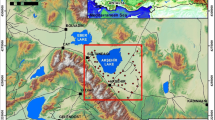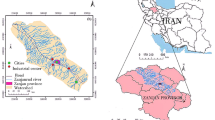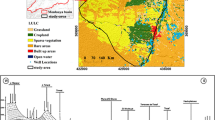Abstract
Ecological (biological and hydrochemical assessment) and hydrogeological (vulnerability and pollution risk mapping) tools have been combined to assess the ecological quality and hydrogeological vulnerability of an agricultural river basin. In addition, the applicability of the recently developed vulnerability assessment approach (COP method) in the particular environmental conditions was tested by comparing its results with hydroecological assessment tools (i.e., pollution metrics). Five sampling sites were selected and sampled for benthic macroinvertebrates and physicochemical variables during summer and spring. Overall, sites ranged from moderate to poor ecological quality. The results illustrated that 26% of the study area was of moderate pollution risk, while 65% was classified as of low and very low risk zones. However, the higher elevation zones where calcareous rock formations are encountered presented moderate to high pollution risk that was accredited by the ecological quality assessment. Pollution metrics facilitated from hydrochemical analysis indicated a significant association with groundwater vulnerability, thus validating vulnerability and risk estimations. This study indicated that the particular groundwater pollution risk mapping methodology and the water quality assessment indices can be well combined to provide an integrated evaluation tool at a catchment scale.








Similar content being viewed by others

References
Al-Adamat, R. A. N., Foster, I. D. L., & Baban, S. M. J. (2003). Groundwater vulnerability and risk mapping for the Basaltic aquifer of the Azraq basin of Jordan using GIS, Remote sensing and DRASTIC. Applied Geography (Sevenoaks, England), 23, 303–324. doi:10.1016/j.apgeog.2003.08.007.
Alba-Tercedor, J., & Sanchez-Ortega, A. (1988). Un metodo rapido y simple para evaluar la calidad biologica de las aguas corrientes basado en el de Hellawell (1978). Limnetica, 4, 51–56.
Albanis, T. (1992). Herbicide losses in runoff from the agricultural area of Thessaloniki in Thermaikos Gulf, N. Greece. The Science of the Total Environment, 114, 59–71. doi:10.1016/0048-9697(92)90414-N.
Albinet, M., & Margat, J. (1970). Cartographie de la vulnérabilité à la pollution des nappes d’eau souterraine. Orléans, France, Bull BRGM 2ème série, sect 3, 4, 13–22.
Allan, J. D. (2004). Landscapes and riverscapes: the influence of land use on stream ecosystems. Annual Review of Ecology and Systematics, 35, 257–284. doi:10.1146/annurev.ecolsys.35.120202.110122.
Allan, J. D., Erickson, D. L., & Fay, J. (1997). The influence of catchment land use on stream integrity across multiple spatial scales. Freshwater Biology, 37, 149–161. doi:10.1046/j.1365-2427.1997.d01-546.x.
Andreo, B., Goldscheider, N., Vadillo, I., Vias, J. M., Neukum, C., Sinreich, M., et al. (2006). Karst groundwater protection: First application of a Pan-European Approach to vulnerability, hazard and risk mapping in the Sierra de Lýbar (Southern Spain). The Science of the Total Environment, 357, 54–73. doi:10.1016/j.scitotenv.2005.05.019.
AQEM Consortium (2002). Manual for the application of the AQEM method. A comprehensive method to assess European streams using benthic macroinvertebrates, developed for the purpose of the Water Framework Directive. Version 1.0. Retrieved Feb 2002 from http://www.aqem.de.
Armitage, P. D., Moss, D., Wright, J. F., & Furse, M. T. (1983). The performance of a new biological water quality score system based on macroinvertebrates over a wide range of unpolluted running-water sites. Water Research, 17, 333–347. doi:10.1016/0043-1354(83)90188-4.
Babiker, I. S., Mohamed, A. A. M., Hiyama, T., & Kato, K. (2005). A GIS-based DRASTIC model for assessing aquifer vulnerability in Kakamigahara Heights, Gifu Prefecture, central Japan. The Science of the Total Environment, 345, 127–140. doi:10.1016/j.scitotenv.2004.11.005.
Barbour, M. T., Gerritsen, J., Snyder, B. D., & Stribling, J. B. (1999). Rapid Bioassessment Protocols for Use in Streams and Wadeable Rivers: Periphyton, Benthic Macroinvertebrates and Fish, Second Edition. EPA 841-B-99-002. Washington, DC: US Environmental Protection Agency, Office of Water.
Cardoso, A. C., Duchemin, J., Magoarou, P., & Premazzi, G. (2001). Criteria for the identification of freshwater subject to eutrophication. Their use for the implementation of the “Nitrates” and Urban Waste Water Directives. EUR 19810 EN, EU–JRC, 87.
COST 620. (1998). Vulnerability and risk mapping for the protection of carbonate (karst) aquifers. Minutes from the 3rd MC-Meeting, 8 S., Liège, Belgium, 12–13 March.
Decreto Legislativo.n. 152. (1999). Disposizioni sulla tutela delle acque dall’inquinamento e recepimento della direttiva 91/271/CEE concernete il trattamento delle acque reflue urbane e della direttiva 91/676/CEE relative alla protezione delle acque dall’inquinamento provocato dai nitrati provenienti da fonti agricole. Supplemento Ordinario n. 101/L alla Gazzetta Ufficiale 29 maggio 1999, n. 124.
Dixon, B. (2005). Groundwater vulnerability mapping: A GIS and fuzzy rule based integrated tool. Applied Geography (Sevenoaks, England), 25, 327–347. doi:10.1016/j.apgeog.2005.07.002.
Dodds, W. K., & Oakes, R. M. (2004). A technique for establishing reference nutrient concentrations across watersheds affected by humans. Limnology and Oceanography, Methods, 2, 333–341.
Eckhardt, D. A. V., & Stackelberg, P. E. (1995). Relation of ground-water quality to land use on Long Island, New York. Ground Water, 33, 1019–1033. doi:10.1111/j.1745-6584.1995.tb00047.x.
European Parliament and Council of the European Union. EU Directive 2000/60/EC of the European Parliament and of the Council of 23 October 2000, establishing a framework for Community action in the field of water policy. Official Journal of the European Community 22 December 2000, L 327, 1–72.
Ghetti, P. F. (1997). Indicie Biotico Esteso (I.B.E.). I macroinvertebrati nel controllo della qualitá degli anbienti di acque correnti. Provincia Autonoma di Trento.
Goerfliger, N., Jeannin, P. Y., & Zwahlen, F. (1999). Water vulnerability assessment in karst environments: a new method of defining protection areas using a multi-attribute approach and GIS tools (EPIK method). Environmental Geology, 39, 165–176. doi:10.1007/s002540050446.
Goldscheider, N., Brechenmacher, J., Hotzl, H., & Neukum, C. (2003). Engen, Swabian Alb, Germany. In: F. Zwahlen (Ed.), COST Action 620—Vulnerability and risk mapping for the protection of carbonate (karst) aquifers. Final Report, European Commission Directorate-General XII Science, Research and Development, Report EUR, COST-ACTION 620. Luxembourg, 200–216.
Hellawell, J. M. (1986). Biological indicators of freshwater pollution and environmental management. New York: Elsevier Applied Science.
House, M. A., & Ellis, J. B. (1987). The development of water quality indices for operational management. Water Science and Technology, 19, 145–154.
Hynes, H. B. N. (1960). The biology of polluted water. Cambridge: Liverpool University Press.
Knox, R. C., Sabatini, D. A., & Canter, L. W. (1993). Subsurface transport and fate processes. Boca Raton: Lewis.
Kronvang, B., Bechmann, M., Pedersen, M. L., & Flynn, N. (2003). Phosphorus dynamics and export in streams draining micro-catchments: development of empirical models. Journal of Plant Nutrition and Soil Science, 166, 469–474. doi:10.1002/jpln.200321164.
Lake, I. R., Lovett, A. A., Hiscock, K. M., Betson, M., Foley, A., Sünnenberg, G., et al. (2003). Evaluating factors influencing groundwater vulnerability to nitrate pollution: developing the potential of GIS. Journal of Environmental Management, 68, 315–328. doi:10.1016/S0301-4797(03)00095-1.
Ministry of Development of Greece (1996). Plan for management program of water resources of Greece. Athens, pp. 56–64.
Munne, A., Prat, N., Sol, C., Bonada, N., & Rieradevall, M. (2003). A simple field method for assessing the ecological quality of riparian habitat in rivers and streams: QBR index. Aquatic Conservation: Marine & Freshwater Ecosystems, 13, 147–163. doi:10.1002/aqc.529.
Raven, P. J., Boon, P. J., Dawson, F. H., & Ferguson, A. J. D. (1998). Towards an integrated approach to classifying and evaluating rivers in the UK. Aquatic Conservation: Marine & Freshwater Ecosystems, 8, 383–393. doi:10.1002/(SICI)1099-0755(199807/08)8:4<383::AID-AQC303>3.0.CO;2-L.
Rosenberg, D. M., & Resh, V. H. (1993). Freshwater biomonitoring and benthic macroinvertebrates. New York: Chapman Hall.
Roth, N. E., Allan, J. D., & Erickson, D. L. (1996). Landscape influences on stream biotic integrity assessed at multiple spatial scales. Landscape Ecology, 11, 141–156. doi:10.1007/BF02447513.
Rundquist, D. C., Rodekohr, D. A., Peters, A. J., Ehrman, R. L., Di Liping, & Murray, G. (1991). Statewide groundwater-vulnerability assessment in Nebraska using the DRASTIC/GIS model. Geocarto International, 6, 51–58. doi:10.1080/10106049109354307.
Sandin, L., & Johnson, R. K. (2004). Local, landscape and regional factors structuring benthic macroinvertebrate assemblages in Swedish streams. Landscape Ecology, 19, 501–514. doi:10.1023/B:LAND.0000036116.44231.1c.
Skoulikidis, N. (2002). Typological and qualitative characteristics of Greek-interregional Rivers. Mediterranean Marine Science, 3(1), 79–88.
Skoulikidis, N., Gritzalis, K., Kouvarda, T., & Buffagni, A. (2004). The development of an ecological quality assessment and classification system for Greek running waters based on benthic macroinvertebrates. Hydrobiologia, 516, 149–160. doi:10.1023/B:HYDR.0000025263.76808.ac.
Skoulikidis, N., Amaxidis, Y., Bertahas, I., Laschou, S., & Gritzalis, K. (2006a). Analysis of factors driving stream water composition and synthesis of management tools—A case study on small/medium Greek catchments. The Science of the Total Environment, 362, 205–241. doi:10.1016/j.scitotenv.2005.05.018.
Skoulikidis, N., Amaxidis, Y., Bertahas, I., & Laschou, S. (2006b). Nutrient levels and origin in a mountainous catchment. Paper presented at the 8th Panhellenic Symposium of Oceanography and Fisheries, Thessaloniki, Greece, June.
Stambuk-Giljanovic, N. (1999). Water quality evaluation by index in Dalmatia. Water Research, 33, 3423–3440. doi:10.1016/S0043-1354(99)00063-9.
Strayer, D. L., Beighley, E. R., Thompson, L. C., Brooks, S., Nilsson, C., Pinay, G., et al. (2003). Effects of land cover on stream ecosystems: roles of empirical models and scaling issues. Ecosystems (New York, NY), 6, 407–423. doi:10.1007/s10021-002-0170-0.
Tesoriero, A. J., Inkpen, E. L., & Voss, F. D. (1998). Assessing groundwater vulnerability using logistic regression. Paper presented at the Source Water Assessment and Protection Conference, Dallas, April.
Vannote, R. L., Minshall, G. W., Cummins, K. W., Sedell, J. R., & Cushing, C. E. (1980). The river continuum concept. Canadian Journal of Fisheries and Aquatic Sciences, 37, 130–137.
Verdonschot, P. M. F. (2000). Integrated ecological assessment methods as a basis for sustainable catchment management. Hydrobiologia, 422-423, 389–412. doi:10.1023/A:1017094905369.
Vrba, J., & Zoporozec, A. (1994). Guidebook on mapping groundwater vulnerability. International Contributions to Hydrogeology, 16, 131.
Ward, J. V. (1998). Riverine landscapes: biodiversity patterns, disturbance regimes, and aquatic conservation. Biological Conservation, 83, 269–268. doi:10.1016/S0006-3207(97)00083-9.
Winter, T. C., Harvey, J. W., Lehn Franke, O., & Alley, W. M. (1998). Ground water and surface water; a single resource. US Geological Survey Circular 1139.
Woli, K. P., Nagumo, T., Kuramochi, K., & Hatano, R. (2004). Evaluating river water quality through land use analysis and N budget approaches in livestock farming areas. The Science of the Total Environment, 329, 61–74. doi:10.1016/j.scitotenv.2004.03.006.
Zalidis, G., Stamatiadis, S., Takavakoglou, V., Eskridge, K., & Misopolinos, N. (2002). Impacts of agricultural practices on soil and water quality in the Mediterranean region and proposed assessment methodology. Agriculture Ecosystems & Environment, 88, 137–146. doi:10.1016/S0167-8809(01)00249-3.
Zhang, W. L., Tian, Z. X., Zhang, N., & Li, X. Q. (1996). Nitrate pollution of groundwater in northern China. Agriculture Ecosystems & Environment, 59, 223–231. doi:10.1016/0167-8809(96)01052-3.
Acknowledgments
The data of this work were collected within the framework of the STAR project. STAR was funded by the European Commission, 5th Framework Program, Energy, Environment and Sustainable Development, Key Action 1: Sustainable Management and Water Quality. (EVK-CT-2001-00089) and by the General Secretariat for Research and Technology, Ministry of Development, Greece. The authors wish to thank the two anonymous reviewers for their valuable comments and suggestions towards the improvement of this manuscript.
Author information
Authors and Affiliations
Corresponding author
Rights and permissions
About this article
Cite this article
Karaouzas, I., Dimitriou, E., Skoulikidis, N. et al. Linking Hydrogeological and Ecological Tools for an Integrated River Catchment Assessment. Environ Model Assess 14, 677–689 (2009). https://doi.org/10.1007/s10666-008-9183-1
Received:
Accepted:
Published:
Issue Date:
DOI: https://doi.org/10.1007/s10666-008-9183-1



